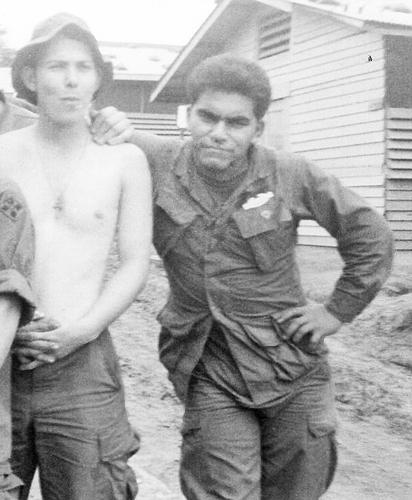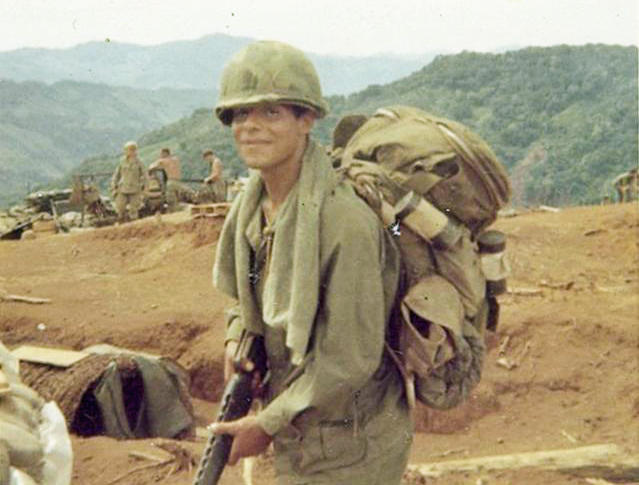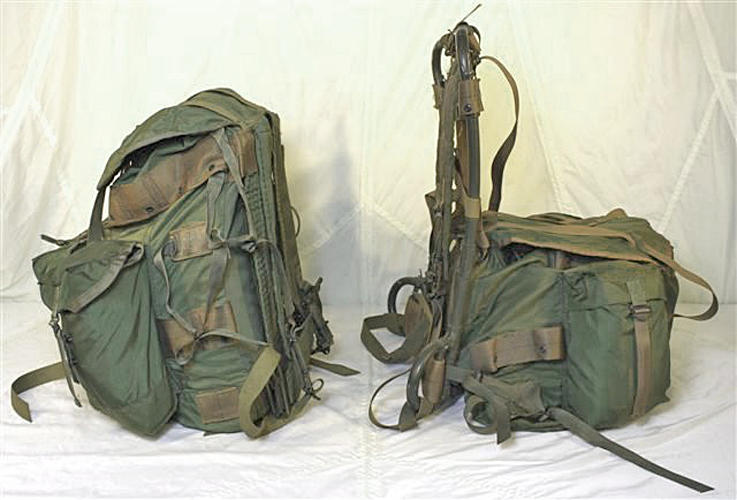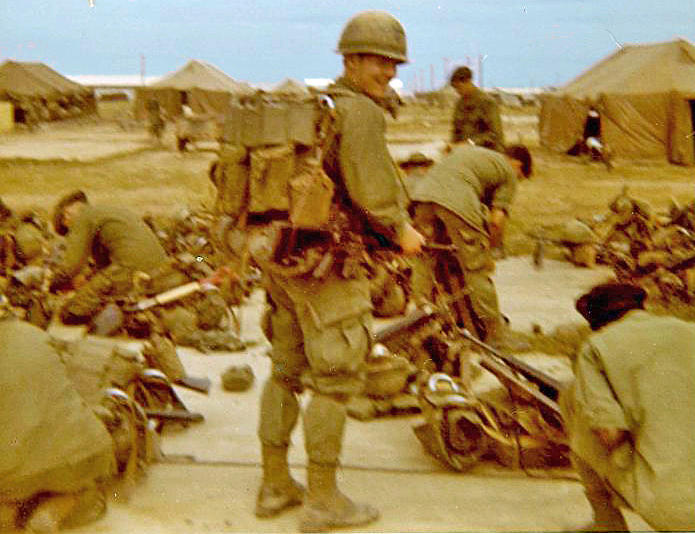![]() 1st Battalion 22nd Infantry
1st Battalion 22nd Infantry ![]()
The Jungle
Humping the boonies
We carried all our gear in heavy rucksacks on our backs, moving up and down those mountains. Thrashing through the jungle, with a heavy load strapped to our backs was known as “humping the boonies.” We stopped every four or five days to get re-supplied by helicopter. Sometimes we would find a clearing for the helicopters to bring in the re-supply. Other times we had to make a clearing out of the jungle. At one such place where Engineers had been flown out to help us make a landing zone, we cut down many trees, and even blew a few down with explosives. At that landing zone Dodd “Utah” Owens and I were pinned down by an enemy sniper for about an hour before artillery could be called in, which allowed us to run for the safety of the trees.
We moved in what they called a clover leaf operation. One platoon went straight ahead. The two other platoons went to the right and left, making big circles to come back to the central line of travel on the fourth or fifth day, to join all the platoons back together again for the re-supply. We walked on trails about half the time. The other half the time we hacked our way through the jungle with machetes. Those times would wear out a point element reasonably fast so we rotated that chopping and hacking job. A real eye opener was to chop our way through foliage, and suddenly be confronted on our side by a sheer drop of a hundred or more feet, because we had hacked our way close to the edge of a cliff.
Jungle foliage was primeval with bushes and vines of every kind all among the trees. Some of the trees were huge with giant exposed roots that resembled something from prehistoric times or hell itself. The “wait a minute vine” was everywhere. It was a vine that came in small and large sizes and had thorns along its length. Many of those thorns were big, and sharp enough to get stuck inside gear or clothing and actually prevented us from moving any further until we dislodged ourselves from it. Hence the name “wait a minute”. Sometimes I needed a buddy to help me get free from one of those vines.
According to the patrol grid maps of the area we were in, the highest mountains were about 3200 feet high with the average mountain top being 1600-2600 feet. They seemed higher. We moved up and down those mountains slowly. Very often we held on to vines (if they had no thorns), saplings, or anything that could help give us a hand, both going up and coming down. One day, at a place coming down a mountain side, the ground fell sharply in a “drop off” for a distance of about seven feet or so. Each one of us in turn grabbed onto a vine and lowered ourselves, climbing down the wall of that drop off. When Ramon Gama got to it he simply jumped those seven feet straight down and landed on his feet as if it were nothing. The whole time with his heavy rucksack strapped to his back. Those of us who saw that feat were plumb amazed by it. Gama was a marvel. He was strong, he was brave, and he was a heck of a nice guy. Many of us would sometimes run out of food or water before being re-supplied. Gama would unhesitatingly share his food and water with someone and never criticize them for not carrying enough.

Me on the left - Ramon
Gama on the right.
Base Camp at An Khê 1970.
Photo by John Bryce, Sergeant, Company C 1/22 Infantry 1970-1971.
Very seldom did we come upon open areas. When we did, we crossed them quickly, with an awful lot of space in between each man. Elephant grass grew in many places where the jungle did not. It was simply tall, thick grass. That stuff could grow as high as 10 or 15 feet. I remember an especially tall patch we walked through near a stream and we made tunnels going through it. Occasionally we would come across one or more huge bomb craters which could be quite impressive as to their size. We took water from streams. High in the mountains those streams were clear, but down lower some of those streams were dark, muddy, and putrid looking. If the water looked halfway decent we filled our canteens with it. Much of the time many of us put Army issue water purification tablets (either Iodine or Halazone) in each canteen full. I would add an entire packet of Kool Aid (that I had folks back home send me) to each canteen to kill the yucky taste of the tablets.
Most of the time we slowly lumbered our way through the jungle, stopping every day around four or later in the afternoon to build a night time position. We would dig foxholes and snap ponchos together over branches cut as poles, to make tents, which we called a “hooch”. Usually before it got dark we would send patrols out to scout around our position, or to go back down a trail to see if anyone was following us. On a few of those patrols I went on we detected movement in the jungle. Occasionally someone would see a flash of a human form for just an instant. Sometimes that was sufficient to send us running back through the jungle to our defensive position at high speed, and prompted us to build our position a little stronger.
On one occasion we found a thatched hut near the bottom of a mountain, very near a small stream. As the point element was investigating the hut, they saw, across the stream in an open area, two enemy soldiers obviously returning to the hut. As our guys set up a machine gun to ambush the enemy, one of our Vietnamese Kit Carson Scouts opened fire on the two soldiers, missing them and causing them to run into the jungle before the machine gun was in position. It was speculated he may have done so on purpose to allow them to escape being killed or captured. Our machine gun fired into the jungle after them anyway, but the enemy was gone.
We received a change of clothes on an irregular basis. Laundered fatigues were loaded into duffel bags and brought by the helicopters with the re-supply sometimes. The contents of the bags were dumped into a heap, and soldiers dug through the pile to find shirts and trousers to fit them. Since I had such short legs I usually ended up with trousers too long. Much of the time I ended up cutting off the bottoms of the legs of a pair of trousers, to better fit me. We shared a laundry pool with the 173rd Airborne Brigade, so often we got shirts with their insignia on them.
Our platoon medic, Ron “Doc” Sorrento took care of us out there in the wilderness. He patched up our cuts and scrapes, lanced and drained the sores from jungle rot that most of us got (by the end of the mission the ones on my legs had to be lanced and drained every day), and made sure we took our malaria pills every day. One of the first faces we saw every morning was Doc Sorrento’s, as he came to each soldier and told him “open your mouth” and then tossed a little white malaria pill down the soldier’s throat. Once a week he also made sure we took the big orange malaria pill in addition to the daily little white pill.
Doc Sorrento was our doctor, shrink, and big brother out in the jungle. When Jackson and Reed were blown up by the booby trap it was Doc Sorrento who rushed to help them. One of them was killed instantly, but the other died while Doc worked feverishly but unsuccessfully to save his life. We all knew that if one of us was wounded, he would put his life in danger to help us. We therefore put a high value on his life and protected him to the best of our ability. He has my undying respect forever and will always be a special hero to me.

Ronald “Doc” Sorrento – Medic for 3rd Platoon
We had a Forward Observer (FO) with us, who was a Sergeant or Officer from one of the Artillery units, and who humped the boonies with us. Usually every day, before it got dark, he would call in spotter rounds from one of the artillery batteries on a firebase in the area. This was in order to have pre-planned coordinates for artillery strikes, should we be attacked by the enemy. Those spotter rounds were not high explosive, but smoke rounds instead, and by observing where they landed, the FO could adjust the fire and place them where he wanted, in locations around us which he would designate as named targets for the guns.
That way, if something happened, he did not have to adjust artillery fire, he would simply tell them to fire at Target Delta for instance. When he called for those spotter rounds the word was passed among us with the cry of “Rounds out!” to let us know to seek cover in case the rounds fell too close. Even though they were not explosive, those smoke rounds could injure or even kill someone. The FO we had on that mission loved being out in the boonies. When we were pulled out of the jungle at the end of the mission, he checked with his headquarters and found another unit who was still out on a mission, and requested that he be allowed to join them.
None of us got a haircut while out in the jungle, and most of us didn’t shave either, as we saw it as a waste of precious water. When we finally left the jungle at the end of the mission, a razor was passed around and we all had to shave before getting on the helicopters that brought us to the Base Camp. The FO had been out in the boonies so long that he had long frizzy hair for a G.I., and a fat, full beard that made him look like the guitar player Gerry Garcia, from the band the Grateful Dead. Since he was not returning to the Base Camp with us, but was going to join another unit somewhere out in the boonies, the FO did not shave that beard.
Why we were called "grunts"
The standard Army issued gear for an Infantryman during the Vietnam era was the M1956 Load Carrying Equipment. This consisted of a canvas pistol belt worn around the waist, to which could be affixed ammunition pouches, canteens, a small field pack and other items of equipment. A shoulder strap harness could be attached to the front and back of the belt and thus distributed some of the weight from the waist to the shoulders. This system worked well enough for operations in the field lasting no more than one or two days. For long, sustained field operations in the remote areas of Vietnam the Army developed several varieties of rucksack.
I was given a rucksack when I processed into my Company at Camp Radcliff, the Base Camp at An Khe. The clerk who gave it to me just randomly picked it out of a pile of equipment. The setup I was given was not normal issue and I would come to really appreciate it. Instead of a standard issue Lightweight Rucksack the rig I was given had a Tropical Rucksack. The Lightweight Rucksack was affixed to a tubular aluminum frame, while the Tropical Rucksack had its own integral spring steel x-frame. My rig was a Tropical Rucksack affixed to the tubular aluminum frame of a Lightweight Rucksack. The Tropical Rucksack was larger overall and had more attachment points, so I could carry a lot more items and bigger load than the standard rucksack. The rucksack had a large interior pocket, three exterior pockets, and a thin pocket inside the top cover flap.

Left: The Tropical
Rucksack
Right: The Lightweight Rucksack with its tubular frame.
I carried a Tropical Rucksack lashed to the tubular frame of a
Lightweight Rucksack.
The interior pocket of the Tropical Rucksack was much larger than
the interior pocket of the
Lightweight Rucksack. The exterior pockets of the Tropical
Rucksack were slightly larger also.
Photo by Ed Nored from the D Company 1st Bn 8th Cav 1st Cav Division RVN 69 - 70 website used by permission
The Lightweight Rucksack had a quick release strap assembly on the left strap, that when pulled, released the rucksack from the left strap, which allowed the wearer to un-drape it from his right shoulder and therefore rid himself of the whole rig rather quickly. My Tropical Rucksack came with a quick release assembly on both shoulder straps. If I needed to, all I had to do was pull both of those quick releases and my rig would drop off my shoulders to the ground immediately.
When the clerk first gave me my rucksack, he packed it for me and told me I would learn for myself what I personally wanted to carry and how I wanted it packed in the rucksack. Within a short time out in the jungle I did learn that for myself and gathered items as to my personal preference. Inside the large interior pocket I stuffed c-rations in their cardboard packing boxes, along with loose cans of rations, plastic wrapped LRRP rations (Long Range Reconnaissance Patrol rations) which were freeze dried entree meals, and any other items that I deemed necessary. In the exterior pockets I had a couple of claymore anti-personnel mines with their wires and detonators, and a couple of trip flares. I had rigged up one of my claymores as a mechanical ambush and carried a large, square 6 volt battery to power it. Affixed to attachment points on the sides of the rucksack I carried four one quart canteens in their canvas canteen pouches. Inside one of those pouches I had a stainless steel canteen cup. As soon as I was able to procure one, I also carried a five quart bladder canteen tied to the top flap of the rucksack.
At the bottom of the rucksack I had a 30 caliber steel ammunition can, inside of which I carried spare socks, letter writing material, cigarettes and anything else I wanted to keep dry. Beneath the can was my bedroll, consisting of a nylon poncho liner, wrapped inside a deflated air mattress, wrapped inside of a waterproof poncho, all rolled up to form a compact bedroll. The bedroll and ammo can were tied to the bottom of the rucksack with long Army bootlaces.
The tubular frame of the rucksack extended out over our hips and sides so that nothing could be attached to the standard pistol belt on the sides or back. For this reason I and many others did not wear a pistol belt. I carried ammunition for my rifle in cloth bandoleers. A standard 20 round magazine for the M-16A1 rifle fit perfectly into a pocket of a bandoleer. Each bandoleer had seven pockets. I wore two bandoleers of magazines tied around my waist with the pockets toward my front. I had a third bandoleer of magazines draped across the top back of my rucksack. Inside the pockets of the rucksack I also had several loose magazines for my rifle, and a 100 round belt of ammunition for the squad M-60 machine gun.
I carried several smoke grenades loosely stuck on my rucksack or the front of my shoulder straps. I was not issued any fragmentation grenades while we were out in the jungle. In one of the cargo pockets on my trousers I stuffed a large rectangular battery in its plastic bag for the squad or platoon PRC-25 radio. Inside the rucksack I carried a one pound block of C-4 plastic explosive, used to heat or cook my c-rations and boil water for coffee. Attached to my trouser belt was a steel carabiner (which we called a "D ring"), to which was attached an Army P-38 can opener (which came in the c-ration cases), and a civilian can opener (which we called a "church key"). Both can openers were attached to the "D ring" using grenade rings. Small items like bottles of insect repellent, gun oil, bandages, cigarettes, matches, small packs of toilet paper, a pocket knife, and other things were stuck in pockets of my shirt or trousers, or anywhere in the rucksack where I could fit them. I took my turn at carrying the large shovel each squad had.
This whole rig, when full after a re-supply, could weigh as much as 80 pounds or more. At 5 foot 6 and 130 pounds I sometimes needed help getting it on to my shoulders. I would place the loaded rig on the ground up against a tree, then sit on the ground in front of it and drape my arms through its shoulder straps. I would then stand up, all the while pushing back against the tree. Sometimes while carrying out that process I needed a buddy to grab my hand and pull me up as well, especially the day or two immediately after a re-supply when the rig was fully loaded.
I carried an M-16A1 rifle that weighed about seven and a half pounds with a loaded magazine. Instead of using the Army issued sling for the rifle I tied a length of claymore wire (like insulated double wire lamp cord) to the front sight post and wrapped around the buttstock, which allowed the rifle to hang from my right shoulder. With one hand on the rifle’s pistol grip this let me have the weapon pointed to my front at about hip level, and thus could be fired “from the hip” if needed. This configuration also left my left hand free to deal with vines or vegetation when walking point. The length of the wire allowed for bringing the rifle up to my shoulder quickly for aimed firing if necessary. The wire also acted like a sling to carry the rifle from my shoulder, so it was always with me, and I didn’t have to lay it down if I needed to use both hands.
Add to all that a steel helmet weighing nearly three pounds on top of my head, and the load I carried, wore, strapped to me, or stuck on me could come to over a hundred pounds. Going up and down those mountains, through all that jungle, with all that weight on me, it’s no wonder I did a lot of grunting.
|
Left: Photo of me taken at Tuy Hoa
December 1970 |

Rear view of my rucksack on me. I’m
carrying a light load, with only two canteens on the ruck
and hardly anything inside the main interior pocket. Bandoleer of
magazines across the top of ruck.
Bedroll at the bottom of the ruck. Note my trousers tucked
tightly into my boots, and straps tied
tightly just below my knees, all to keep leeches from crawling up
the inside of my pant legs.
My boots are unshined, dirty, and mightily scuffed up, a normal
state of existence of Infantry
in Vietnam.
Copyright © Michael Belis 2020
All rights reserved
Home | Photos | Battles & History | Current |
Rosters & Reports | Medal of Honor | Killed
in Action |
Personnel Locator | Commanders | Station
List | Campaigns |
Honors | Insignia & Memorabilia | 4-42
Artillery | Taps |
What's New | Editorial | Links |